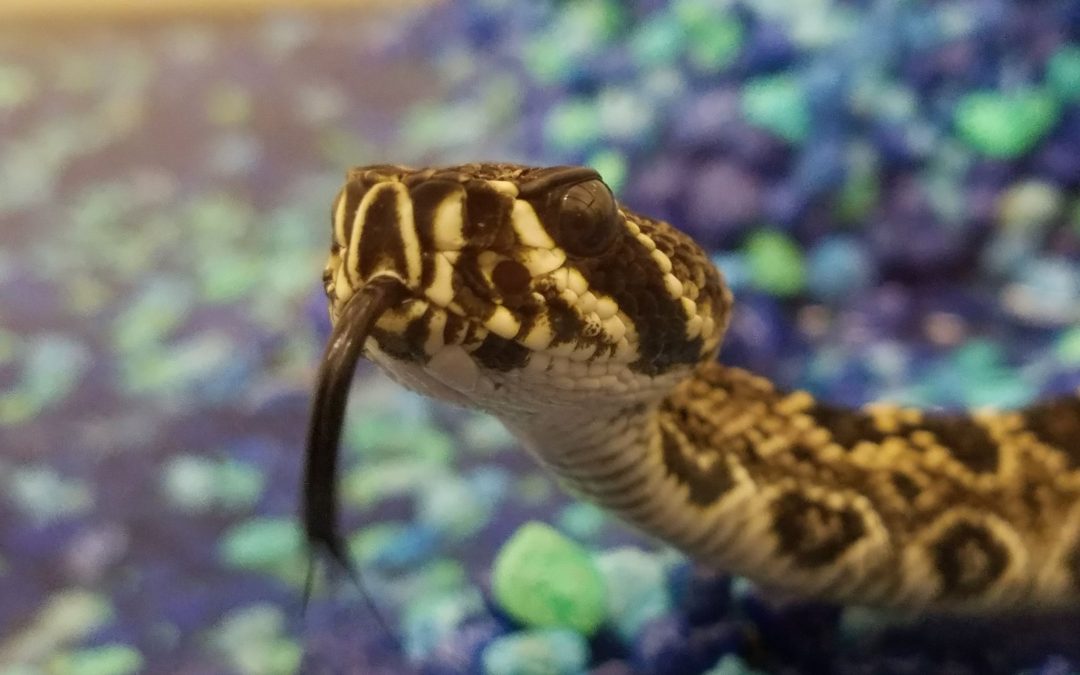
by Evan Anderson | Oct 10, 2025
Snakes of the Panhandle
Love them or hate them, snakes are a common sight in the Florida panhandle. It can be tempting to lump all snakes into the category of ‘kill it on sight!’, but that approach isn’t the best. They can be harmful or beneficial – nobody wants a snakebite, venomous or not, but snakes can play a valuable role in the ecosystem, keeping rodent populations under control.
Plenty of the snakes we have in the panhandle are harmless to humans. Only six species in the panhandle are venomous, and not all are found across the entirety of the panhandle. There are plenty of other nonvenomous snakes, some of which may resemble dangerous ones.
Some of the most common nonvenomous snakes include:
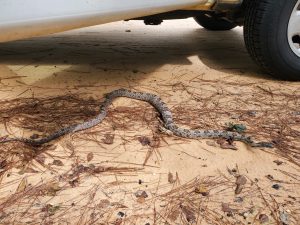 Rat snakes – Harmless, unless you’re a mouse or rat, the gray rat snake is also referred to as an oak snake. Very common and sometimes bred in captivity, especially red rat snakes.
Rat snakes – Harmless, unless you’re a mouse or rat, the gray rat snake is also referred to as an oak snake. Very common and sometimes bred in captivity, especially red rat snakes.
Black racers – One of the more commonly spotted snakes in the daytime, black racers live in urban and suburban environments. Adults are black with a white chin, feeding on rodents, lizards, frogs, birds, or even other snakes.
Ringneck snakes – Common but reclusive, the ringneck snake is small, black on top with a bright yellow underside that changes to orange near the tail. A distinct yellowish ring on its neck gives it its name. Not venomous, and does not bite.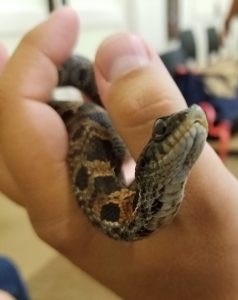
Hognose snakes – Living in dry, sandy habitats, hognose snakes are relatively small, with a distinctive upturned nose. They use this nose like a shovel, burrowing after the toads they feed on. Harmless to people, they try to appear threatening when disturbed and switch to playing dead if that doesn’t work.Garter snakes – Variable in color, but often with long stripes running the length of their bodies. Found near water, garter snakes may try to bite or release a foul smelling musk if captured. They are not venomous, however.
Water snakes – Several species of nonvenomous water snakes call the panhandle home. They live near ponds, lakes, canals, rivers, creeks, and other fresh water bodies. Most will try to bite if handled, and release foul smelling musk as a defense. They usuall feed on small fish, frogs, or sometimes small invertebrates.
King snakes – Looking very similar to the venomous coral snake, the scarlet kingsnake is not dangerous itself. It is small and likes to burrow, feeding on small lizards and rodents. It has bands of red, black, and white or yellow, but the red and white (or yellow) do not touch.
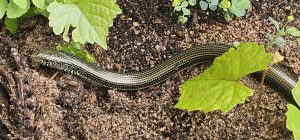 Glass lizards – Active during the daytime, these are legless lizards rather than actual snakes. Their name refers to their ability to detach their tails when in danger. The tail continues to wriggle, distracting predators while the lizard itself escapes. They eat a wide variety of insects, small creatures, eggs, and even smaller glass lizards.
Glass lizards – Active during the daytime, these are legless lizards rather than actual snakes. Their name refers to their ability to detach their tails when in danger. The tail continues to wriggle, distracting predators while the lizard itself escapes. They eat a wide variety of insects, small creatures, eggs, and even smaller glass lizards.
The varieties of venomous snakes found in the Florida panhandle are:
Pygmy rattlesnakes – Small, well camouflaged in the pine forests it inhabits, pygmy rattlesnakes are aggressive. They do have a rattle, but the sound they make is a quiet buzz more like the sound an insect might make. They normally eat frogs or other small creatures, and while a bite is unlikely to be deadly to a human, it can be painful and cause infection.
Canebreak or timber rattlesnakes – A larger rattlesnake, these can grow up to six and a half feet in length. They prefer to flee rather than fight, but can be potentially lethal if they do bite.
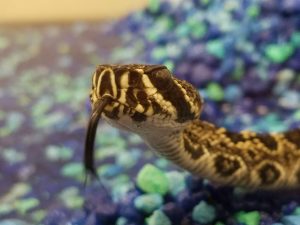 Diamondback rattlesnakes – As its name suggests, it has diamond-shaped patches along its back. Growing up to eight feet long, the diamondback rattlesnake can be dangerous and should not be approached within six feet, as it can strike quickly up to half its body length away. Thankfully, it is not particularly aggressive unless approached, and tries to warn off intruders with its rattle which produces a loud warning buzz.
Diamondback rattlesnakes – As its name suggests, it has diamond-shaped patches along its back. Growing up to eight feet long, the diamondback rattlesnake can be dangerous and should not be approached within six feet, as it can strike quickly up to half its body length away. Thankfully, it is not particularly aggressive unless approached, and tries to warn off intruders with its rattle which produces a loud warning buzz.
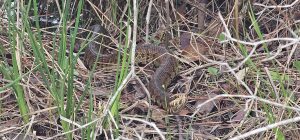 Cottonmouths or water moccasins – Found near water, the cottonmouth is named for its habit of opening its mouth, which has a whitish lining, as a threat. It may not flee when approached, and can strike aggressively. Its bite is potentially lethal.
Cottonmouths or water moccasins – Found near water, the cottonmouth is named for its habit of opening its mouth, which has a whitish lining, as a threat. It may not flee when approached, and can strike aggressively. Its bite is potentially lethal.
Copperheads – Only found in a few specific parts of the panhandle, the copperhead is marked with alternating bands of light and dark brown. Juvenile cottonmouths often resemble copperheads. The copperhead often hides beneath logs or in wood piles, and is well camouflaged amongst piles of leaves. The bite is very painful.
Coral snakes – Seldom seen, but very venomous. Coral snakes can grow to sizes of up to four feet in length, and are colored with bands of red, yellow, and black. The red bands touch yellow ones, unlike on the king snake. Coral snakes are not particularly aggressive and prefer to flee, but its venom is a potent enough neurotoxin to make caution very much advised.
Snake bites are not common, and fatalities from them are less than ten annually in the United States. Wear appropriate clothing when in wild areas, and watch where you step. Do not approach wild snakes, and do not handle freshly killed snakes. In case of a snakebite, call 911 immediately, even if symptoms are delayed. Do not risk further bites in an attempt to identify the snake – stay away! Immobilize the bitten area and keep it lower than the heart, and do not apply suction, ice, heat, or a tourniquet. Do remove tight clothing or jewelry near the bite. Note the time of the bite, what symptoms occur, and any first aid given to the victim so first responders have all the information they need.
Evan Anderson
Walton County Horticulture Agent
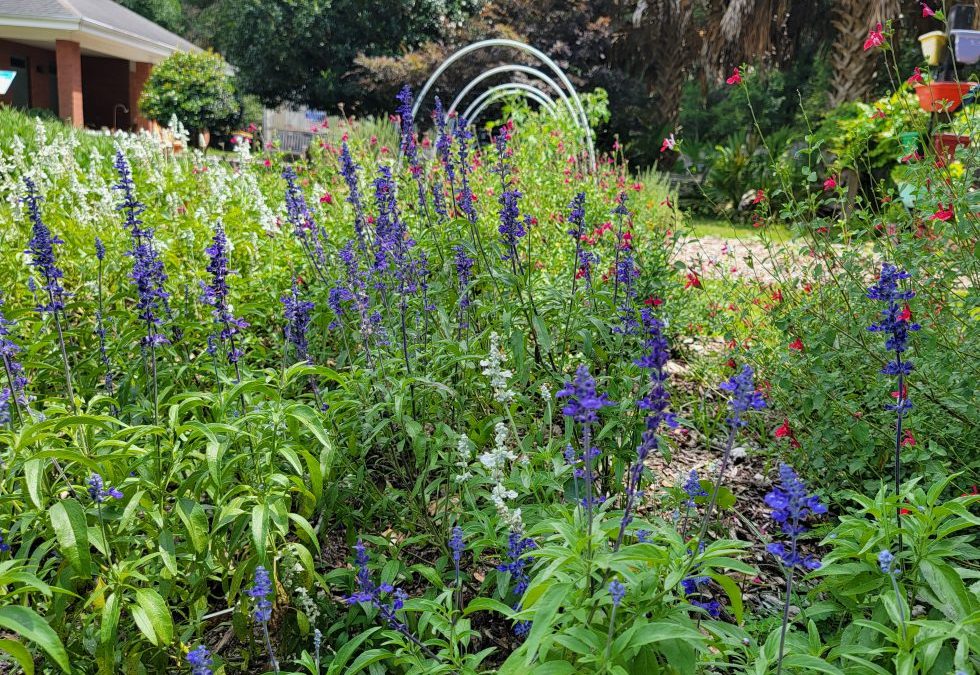
by Joshua Criss | Oct 10, 2025
Planning landscaping is undoubtedly not easy. The primary concern relegated to each individual homeowner is what you want out of your yard. Many are content with just grass, while others desire a diverse array of plant life. One aspect oft overlooked is your landscape’s capacity to be a boon for local wildlife. With a bit of planning, your property could be literally buzzing with insect pollinators, wild birds, and even our reptilian friends.
Where to Start
For this article, let’s begin with a newly established development. What has happened in this scenario from an ecological perspective, with what we’d call primary succession? In short, this means an area that experienced a complete reset of its plant communities. In nature, this would be the result of events such as a volcanic eruption, but in Florida, it’s far more likely due to bulldozers.
Now, the good news in this scenario is that you won’t be receiving your property in this condition. The developer has fast-tracked the process by planting grasses and some basic trees by the time you’ve purchased the property. It’s from this basic setup that you, my new homeowning friends, can begin your husbandry of our local animals.
Begin by investigating the where your new home was built. If it began as a wetland, you’ll want to select plants appropriate for that environment. The same is true if you’ve moved into what was forest land. This thought aligns directly with the first of our FL Friendly Landscaping principles: right plant, right place. There is little sense in putting plants that don’t like wet feet into a poorly draining soils common in wetlands.
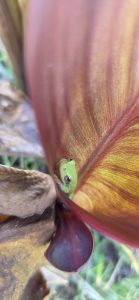
UF/IFAS Photo: J. Criss
Consider Your Environment
You’ll also want to investigate the wildlife that is endemic to those environments and areas. Knowing what is there, and what you’d like to attract to your landscape, will help you decide which plants will be best. For instance, replacing a crape myrtle (Lagerstroemia indica) with a red maple (Acer rubrum) in what was previously a wetland environment puts a tree better suited to that environment, which will require less maintenance from the homeowner. Additionally, red maples are known to be an early-season nectar source for a multitude of moths and butterflies while providing nesting sites for local birds.
Red maples are a great example of plant selection and what it can do to attract wildlife to your yard, but there are other guidelines with which you’ll want to be familiar should this be your goal.
Guidelines for Attracting Wildlife
Water is critical to all life on the planet, including wildlife. Providing water features in your garden will increase the chance for animals visits to your garden. This can be as basic or as elaborate as you’d like. Everything from a pond to a simple dish of water will suffice. One common water feature challenge to consider for Florida gardeners are mosquitos. Avoiding these pesky creatures could be as easy as creating flowing water features. Solar fountains are an easy and cheap way to accomplish that goal.
Shelter is another critical aspect to attract wildlife. Either natural or man-made, it is essential to attracting and keeping various species in your yard. Bird, bat, or owl houses are perfect solutions to this issue. Just ensure you site them correctly to provide the correct environment for the animal in question.
Design your landscape to be layered. In this instance, this means integrating shrubs, trees, herbaceous plants, and groundcover. Doing so will provide some cover for feeding while providing visual interest to your home.
Last and certainly not least, choose plants known to be a food source. When doing so, you’ll want to research how those animals you’d like to attract eat. For instance, hummingbirds (Trochilidae) have a small, curved beak. If this is the species you’d like, you’ll want to select plants rich in nectar with tubular flowers. Firebush (Hamelia patens) is an excellent example of a plant for this purpose.
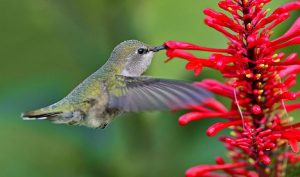
UF/IFAS Photo
Conclusion
Bringing local wildlife into your yard is an excellent way to get to know the small creatures living in your area. A few simple changes may go a long way toward reintroducing habitat to an area where it may be waning. For more information on attracting wildlife or any horticulture topic, refer to your local Extension office

by Danielle S. Williams | Oct 3, 2025
Peanuts, also known as groundnuts, earthnuts or goobers have a long history of cultivation. Unlike tree nuts, peanuts are grown underground which is how they earned the nicknames groundnut or earthnut. Originally native to South America, peanuts made their way to North America from Africa, where they were introduced by African slaves in the early 1800’s.
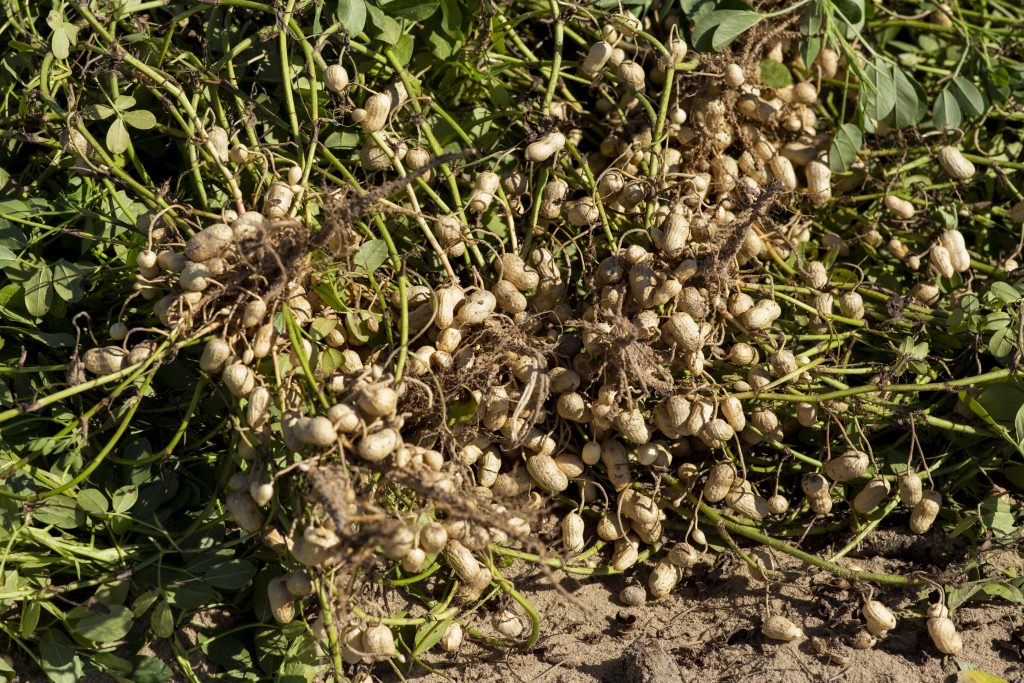
Overturned peanuts in a field ready to be harvested. UF/IFAS Photo by Tyler Jones
First grown in Virginia, peanuts were grown mainly for oil, food, and as a cocoa substitute. During this time, they were regarded as food for livestock and the poor. It wasn’t until the late 1800’s did their demand increase as there was a need for an affordable, high-protein food during the Civil War and World Wars. Their popularity also increased when showman, P.T. Barnum began selling hot roasted peanuts at his traveling circuses.
In the 1900’s, peanuts became a significant agricultural crop when the cotton boll weevil threatened the South’s cotton crop. Through the research findings and suggestions of Dr. George Washington Carver, peanuts were grown as a successful cash crop and contributed greatly to the sustainability of the farm. Though Dr. Carver did not invent peanut butter, he did invent more than 300 new uses for the peanut and peanut byproducts including shaving cream, leather dye, coffee, ink and shoe polish.
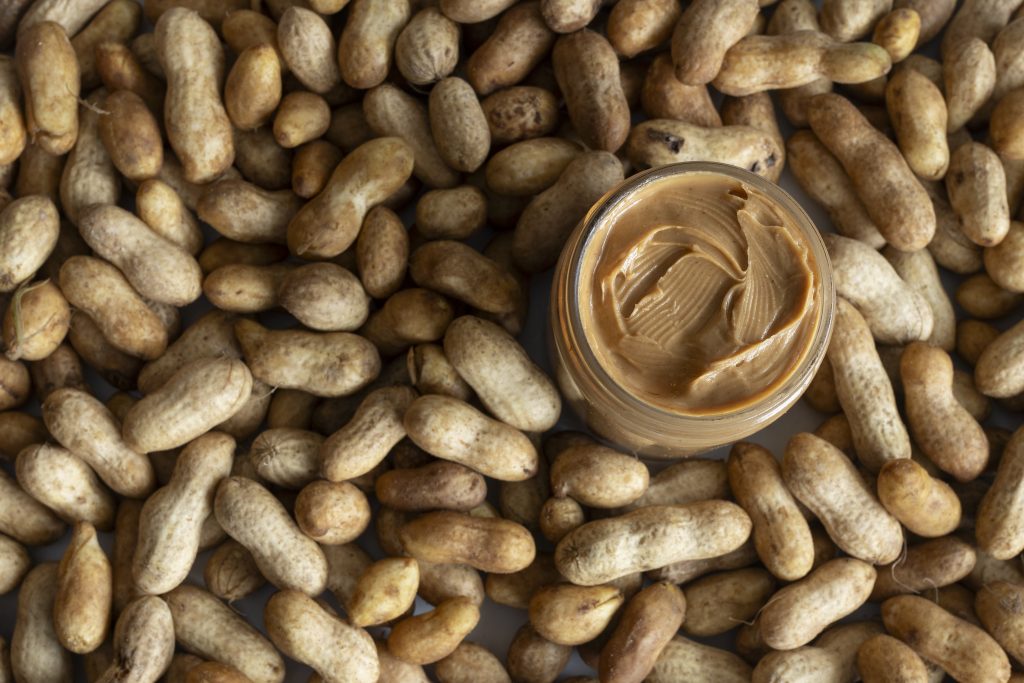
Jar of peanut butter surrounded by loose shelled peanuts. UF/IFAS Photo by Tyler Jones
Today, peanuts are grown in 13 states, across the United States and the U.S. is the third largest producer of peanuts in the world. In 2024, Florida harvested 157,000 acres of peanuts, averaging about 3,500 pounds per acre with a production value of roughly $149.5 million (Annual Crop Production 01/10/2025).
Peanut Fun Facts:
- 99% of peanut farms are family-owned, businesses averaging 200 acres
- There are four different types of peanuts – Runner, Valencia, Spanish and Virginia
- Peanut plants are legumes and fix beneficial nitrogen back into the soil
- Peanut butter is an excellent source of niacin, and a good source of vitamin E and magnesium
- Peanuts do not contain cholesterol and are low in saturated fat
- Peanut butter accounts for half of all peanuts eaten in the U.S.
- It takes about 540 peanuts to make a 12-ounce jar of peanut butter
- There are enough peanuts in one acre to make 35,000 peanut butter and jelly sandwiches
- The average person will eat almost 3,000 peanut butter and jelly sandwiches in their lifetime
- Women and children prefer creamy peanut butter, while most men opt for chunky
- Peanut allergies affect about 1.8% of U.S. children and 1.1% of adults the U.S. population
UF/IFAS Peanut Butter Challenge
Help us fight hunger by donating unopened, unexpired jars of peanut butter to the Peanut Butter Challenge! Every year UF/IFAS Extension Offices across the state coordinate the Peanut Butter Challenge to address hunger and food insecurity in our area. You can support the challenge and help fight hunger by donating unopened, unexpired jars of peanut butter, now through October 31st, 2025 to your local UF/IFAS Extension office. Thanks to support from the Florida Peanut Producers Association and the Florida Peanut Federation, your peanut butter donations go even further!
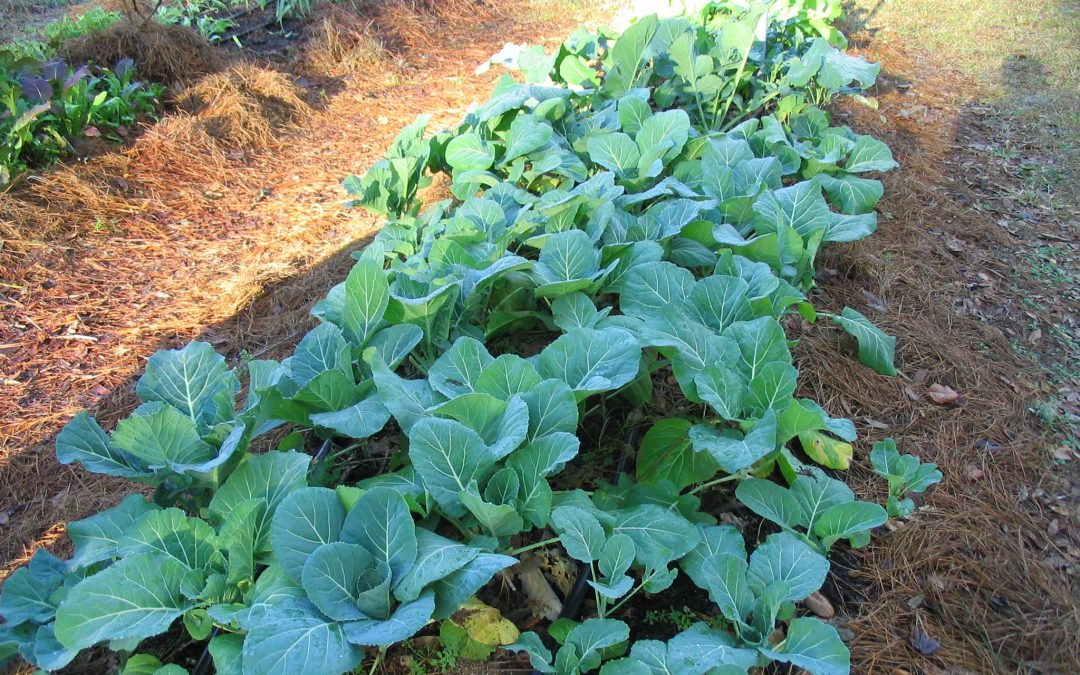
by Molly Jameson | Oct 3, 2025
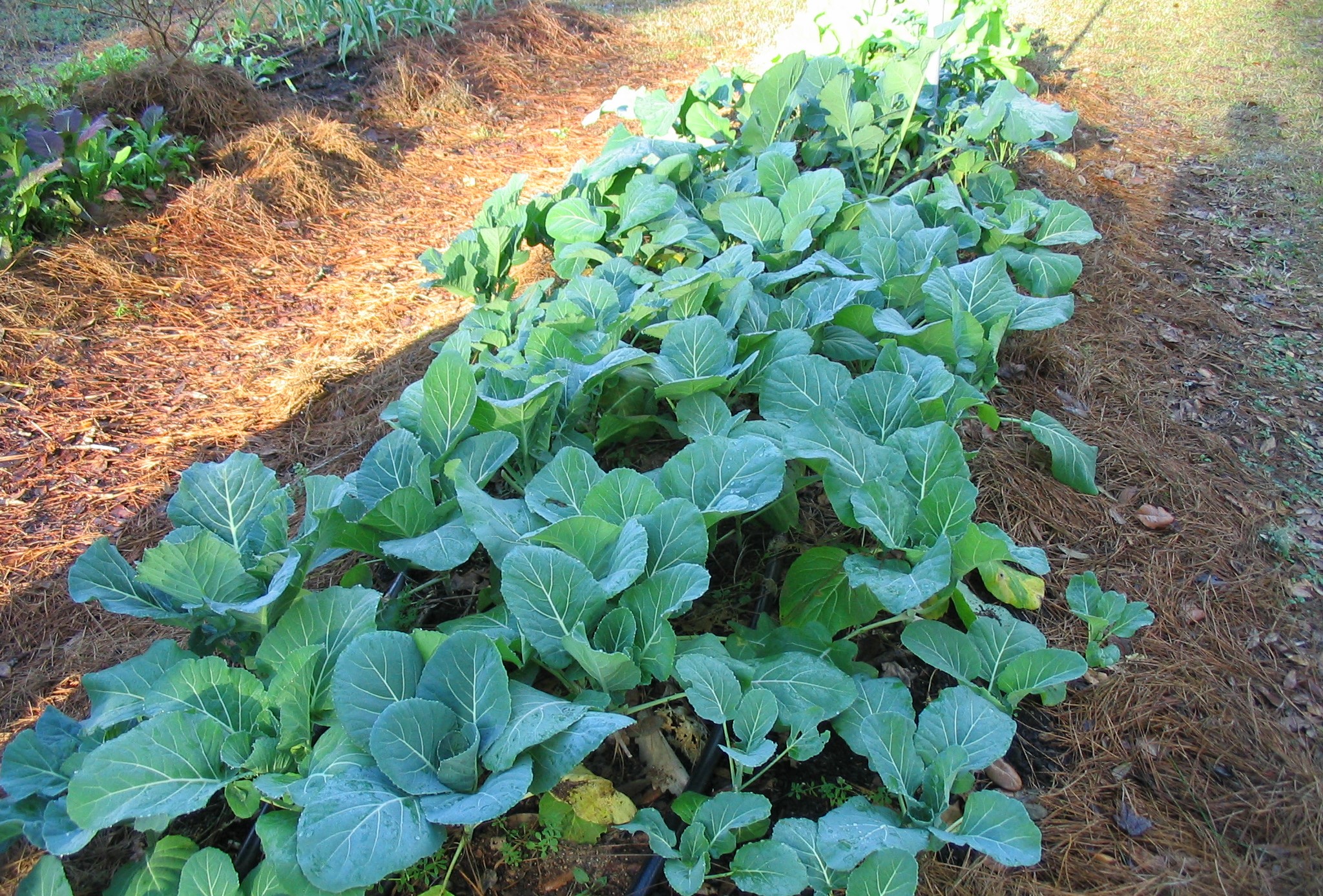
Even a short row of collards can yield basket after basket of tender leaves. Photo by Donna Legare.
Fall Gardening Spotlight: Collard Greens
When cooler weather finally rolls into the Panhandle, collard greens (Brassica oleracea var. acephala) are one of the most reliable crops you can grow. Members of the cabbage family, Brassicaceae, collards are hardy, low-maintenance, and don’t mind a little frost – in fact, a nip of cold will sweeten their flavor. In my neighborhood, it’s not unusual to see collards thriving in gardens all the way through winter and early spring.
Collard seeds can be directly sown starting in late August, with transplants best set out from September through November. If you start from seed, expect to harvest in two to three months. For a quicker turnaround, grab transplants from a local nursery and you’ll be cooking collards by Thanksgiving.
When late summer and early fall heat lingers, young plants may need a little extra care. Providing afternoon shade with a 40 to 50% density shade cloth can keep seedlings from wilting and help them establish more smoothly during warm spells in September. Regular, even watering is also important, but make sure the soil drains well.
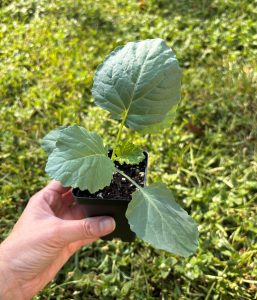
A Georgia Southern collard started indoors in August and up-potted in early September, now ready for transplanting into the fall garden. Photo by Molly Jameson.
Space plants 12 to 18 inches apart in rows two to three feet wide, since collards grow large and need room to spread. In raised beds, you can space plants the same 12 to 18 inches apart in all directions, often in a staggered grid, to make the most of the space. For a steady supply, consider staggering plantings every couple of weeks through early November. Collards are among the more forgiving fall crops – just give them at least six hours of sun, nutrient-rich soil, and steady moisture.
One thing I’ve learned from experience: don’t be shy about picking leaves. Collards will keep producing as long as you harvest from the bottom up, leaving the center growing tip alone. I’ve found the leaves taste best when they’re picked young, around 10 to 12 inches long. If you leave them on longer, they’ll toughen up a bit but hold up well in slow-cooked dishes. Even a short row in the garden can keep a family in collards for much of the season, which helps explain why they’ve been a fixture in Southern kitchens for generations.
Some varieties that do well in our area include several open-pollinated classics. ‘Georgia Southern’ has stood the test of time for its tender, large leaves, while ‘Vates’ is another reliable option, known for its compact size and resistance to bolting. For a collard that’s as pretty as it is productive, try the heirloom ‘Alabama Blue.’ Its bluish leaves are streaked with purple, adding beauty to the garden as well as the plate. If you’d like to try hybrid varieties, look for ‘Champion,’ bred from ‘Vates’ with improved cold tolerance and disease resistance, or ‘Top Bunch,’ which grows quickly and recovers fast after harvest. You’ll usually find at least one or two of these on the racks at local plant nurseries.
While collards are tough, do keep an eye out for caterpillars such as cabbage loopers and diamondback moths, which can chew holes in the leaves. Picking them off by hand usually can keep them under control if you scout often, though a light spray of Bacillus thuringiensis (Bt) can also help if they get ahead of you. Be sure to follow the label directions carefully when applying.
Once you’ve got a basket full of collards, you can make them as simple or as dressed up as you like. I usually just sauté them in olive oil with garlic, salt, and a pinch of smoked paprika. They also slip nicely into soups, mix well with pasta, and can even be blended into green smoothies.
Collards are tough, productive, and delicious – and if you plant a few this fall, you might just find yourself sharing leaves with neighbors well into the new year.

by Lauren Goldsby | Sep 25, 2025
While planning my fall garden I have been partaking in one of my favorite pastimes—shopping for seeds. This is always more fun to me than planting the seeds. Seeds come in many different packages and just like wine, you can be drawn in just from the carefully crafted label. Many of the seed labels I encountered shared the same marketing phrase, “non-GMO seeds”, which is like seeing a gluten free label on your pineapple. It was never an option!

Genetically engineered plants take decade(s) to produce, test and release. They are expensive and are not typically sold in small quantities. These patented seeds will not be sold to you by accident. GMO crops that are grown and sold in the US on a commercial scale include alfalfa, apple (Arctic), canola, corn, cotton, eggplant, papaya, pineapple (pink), potato, soybean, squash, sugarbeet, and sugarcane. More information about each crop here: https://www.ams.usda.gov/rules-regulations/be/bioengineered-foods-list
Recently, a few GE seeds have been developed for the home gardener.

The Firefly Petunia glows in the dark thanks to the insertion of genes from a bioluminescent mushroom. More info
The Purple Tomato has purple skin and purple flesh thanks to the insertion of snapdragon genes. This is the first genetically engineered food crop developed for the home gardener. More info
These seeds are only available from certain retailers, and you will pay a premium for this technology.
When purchasing seeds consider other factors like season and variety. “Right plant, right place” – you hear us say those four words again and again here at the Extension Office. That’s because plant selection is one of the most important things to consider for gardening success. If you were to start a watermelon from seed right now it may do well at first. However, they thrive in the heat of the summer, and they will not like the short, cool fall days. A plant growing in the wrong environment will be stressed. That stress attracts pests and can make a plant more susceptible to pathogens.
Set yourself up for success by growing plants when they are in season. Don’t be tempted by the seeds you see on the aisle end caps. These are not always specific to each region and just because they are selling it now does not mean it should be grown right now. Decide what you are going to grow before you go to the store! The Florida Panhandle Planting Guide is a great resource to use for planning your garden. If you find that you purchased seeds for the wrong season save them for the next one—and consider that your newest hobby may be seed collecting.


 Rat snakes – Harmless, unless you’re a mouse or rat, the gray rat snake is also referred to as an oak snake. Very common and sometimes bred in captivity, especially red rat snakes.
Rat snakes – Harmless, unless you’re a mouse or rat, the gray rat snake is also referred to as an oak snake. Very common and sometimes bred in captivity, especially red rat snakes.
 Glass lizards – Active during the daytime, these are legless lizards rather than actual snakes. Their name refers to their ability to detach their tails when in danger. The tail continues to wriggle, distracting predators while the lizard itself escapes. They eat a wide variety of insects, small creatures, eggs, and even smaller glass lizards.
Glass lizards – Active during the daytime, these are legless lizards rather than actual snakes. Their name refers to their ability to detach their tails when in danger. The tail continues to wriggle, distracting predators while the lizard itself escapes. They eat a wide variety of insects, small creatures, eggs, and even smaller glass lizards. Diamondback rattlesnakes – As its name suggests, it has diamond-shaped patches along its back. Growing up to eight feet long, the diamondback rattlesnake can be dangerous and should not be approached within six feet, as it can strike quickly up to half its body length away. Thankfully, it is not particularly aggressive unless approached, and tries to warn off intruders with its rattle which produces a loud warning buzz.
Diamondback rattlesnakes – As its name suggests, it has diamond-shaped patches along its back. Growing up to eight feet long, the diamondback rattlesnake can be dangerous and should not be approached within six feet, as it can strike quickly up to half its body length away. Thankfully, it is not particularly aggressive unless approached, and tries to warn off intruders with its rattle which produces a loud warning buzz. Cottonmouths or water moccasins – Found near water, the cottonmouth is named for its habit of opening its mouth, which has a whitish lining, as a threat. It may not flee when approached, and can strike aggressively. Its bite is potentially lethal.
Cottonmouths or water moccasins – Found near water, the cottonmouth is named for its habit of opening its mouth, which has a whitish lining, as a threat. It may not flee when approached, and can strike aggressively. Its bite is potentially lethal.












